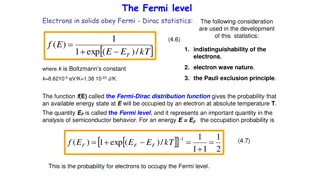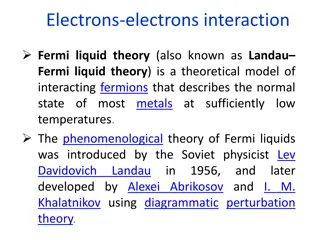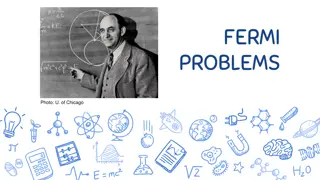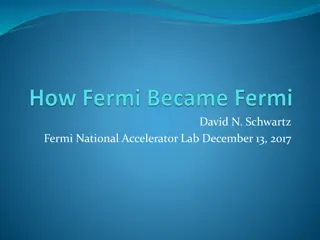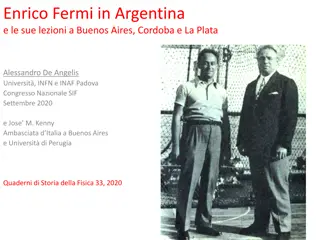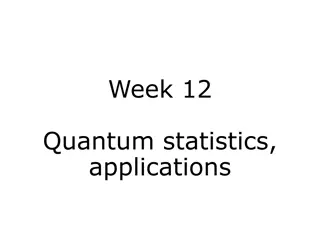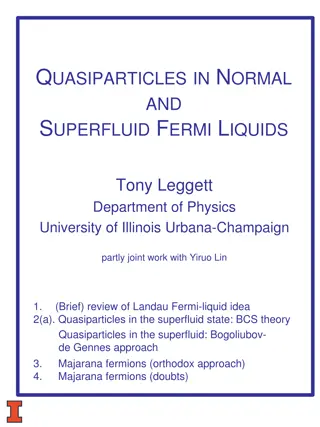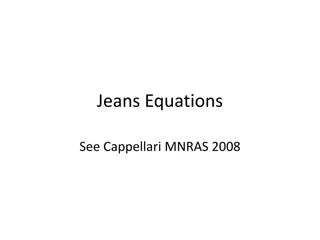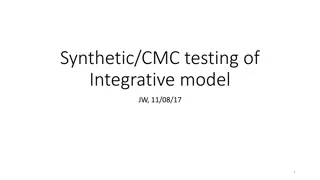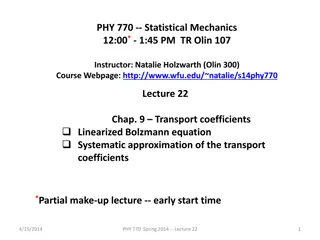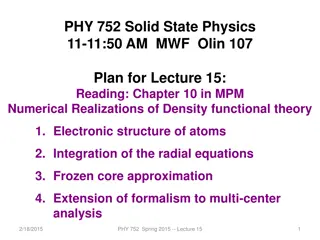Advanced Topics in Theoretical Physics: Boltzmann Equations and Fermi-Golden Rule
Delve into the intricate concepts of the Boltzmann equation, Fermi-Golden Rule, and electron-phonon interactions in this advanced theoretical physics study. Explore the derivations, conservation laws, and linearized Boltzmann equations, uncovering the foundational principles governing electron-phonon systems. Gain insights into the H-theorem, Kubo linear response, and the Fermi-Golden Rule's application in solving complex quantum phenomena.
Download Presentation

Please find below an Image/Link to download the presentation.
The content on the website is provided AS IS for your information and personal use only. It may not be sold, licensed, or shared on other websites without obtaining consent from the author.If you encounter any issues during the download, it is possible that the publisher has removed the file from their server.
You are allowed to download the files provided on this website for personal or commercial use, subject to the condition that they are used lawfully. All files are the property of their respective owners.
The content on the website is provided AS IS for your information and personal use only. It may not be sold, licensed, or shared on other websites without obtaining consent from the author.
E N D
Presentation Transcript
Multiplex-PCR Multiplex PCR is a widely used molecular biology technique for amplification of multiple targets in a single PCR experiment. In a multiplex-PCR assay, different target DNA sequences can be amplified simultaneously by using multiple primer pairs in a reaction mixture. Annealing temperature and primer sets should be optimized so that all primer pairs can work correctly within a single reaction. Amplicon sizes of different genes such as their base pair length should be different so that distinct bands can be visualized by gel electrophoresis.
Multiplex PCR has been used in pathogen identification, high throughput SNP genotyping, mutation analysis, gene deletion analysis, template quantification, linkage analysis, RNA detection and forensic studies.
Plasmid Cloning by PCR Experimental Procedure 1. Run PCR and purify the PCR product: Run PCR to amplify your insert DNA 2. Digest your DNA 3. Isolate your insert and vector by gel purification 4. Ligate your insert into your vector 5. Transformation 6. Isolate the Finished Plasmid 7. Verify your Plasmid by Sequencing
Site directed mutagenesis This is an important molecular biology method to introduce specific and intentional mutations to the DNA sequence of a gene or any genetic products. During this process, firstly a short DNA primer is synthesize which contains the expected mutation and is complementary to the template DNA around the mutation sit so it can hybridize with the DNA sequence of interest. The mutation can be a single or multiple base changes, deletion or insertion. The primer is then elongated by DNA polymerase. Thus the amplified gene then contains the mutated site, which are then incorporated into a host cell as a vector and cloned. At last, mutants are selected by DNA sequencing to select those with desired mutations. This method can be used to study the function of a gene or protein, or for creating variants of an enzyme with new and improved functions.
Viral, Fungal and Bacterial Detection The principle of the method is simple; when a pure PCR product of the 16S rRNA gene is obtained, sequenced, and aligned against bacterial DNA data base, then the bacterium can be identified. 18S rRNA for fungal species identification.
Molecular Markers In genetics, a molecular marker (identified as genetic marker) is a fragment of DNA that is associated with a certain location within the genome. Molecular markers are used in molecular biology and biotechnology to identify a particular sequence of DNA in a pool of unknown DNA.
Molecular Markers Restriction fragment length polymorphism (RFLP) Randomly amplified polymorphic DNA (RAPD) Amplified fragment length polymorphism (AFLP) DNA markers can be co-dominant (a) or dominant (b) in nature.
Restriction fragment length polymorphism (RFLP) In molecular biology, restriction fragment length polymorphism (RFLP) is a technique that exploits variations in homologous DNA sequences, known as polymorphisms, in order to distinguish individuals, populations, or species or to pinpoint the locations of genes within a sequence. 1. The first step in this process is to isolate the DNA from the target. 2. Once the the DNA is isolated from the sample it is subjected to restriction digestion using restriction enzymes. 3. The digested DNA sample is then subjected to gel electrophoresis, in which the DNA is separated based on its size. Many DNA fragments with slight differences in length are produced. 4. The gel is then exposed to a chemical to denature double-stranded DNA to become single- stranded. 5. This is followed by southern blotting where DNA is transferred from gel to nylon membrane. 6. The nylon membrane is then exposed to solution with radioactive complementary nucleotide probes that hybridize to specifically chosen DNA sequences on nylon membrane. 7. The membrane is then placed against X- ray film, where hybridized radioactive probes cause exposure of X-ray film, producing an autoradiogram. 8. RFLP analysis is carried out to detect differences in pattern to confirm polymorphisms.
Applications of Restriction Fragment Length Polymorphism (RFLP) RFLP analysis was formerly an important tool in genome mapping, localization of genes for genetic disorders, determination of risk for disease, and paternity testing. RFLP can be used in many different settings to accomplish different objectives: 1. In paternity cases or criminal cases to determine the source of a DNA sample. (i.e. it has forensic applications). 2. Determining the disease status of an individual. (e.g. it can be used in the detection of mutations) 3. To measure recombination rates which can lead to a genetic map with the distance between RFLP loci. 4. In the characterization of genetic diversity or breeding patterns in animal populations. 5. RFLP has been developed for chromosomes mapping of humans, mice, maize, tomato, rice, etc.
2. Randomly amplified polymorphic DNA (RAPD) Randomly amplified polymorphic DNA (RAPD) is a PCR-based technique which uses arbitrary primers which bind to the nonspecific sites on the DNA and amplify the DNA. These amplified fragments are then migrated on agarose gel and difference in the band pattern is observed. DOMINANT Marker
3. Amplified fragment length polymorphism (AFLP) Amplified fragment length polymorphism (AFLP) is a PCR-based technique that uses selective amplification of a subset of digested DNA fragments to generate and compare unique fingerprints for genomes of interest. Dominant Marker











